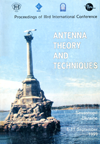On the synthesis of antennas with an optimal ratio between the demand factor and the angle of concentration of the radiated/received power
DOI:
https://doi.org/10.1109/ICATT.1999.1236123Abstract
The demand factor (Kk) introduced in [1] is equal to the ratio between the power radiated by an antenna in some solid angle to the total radiated power. If we define the solid angle as the angle corresponding to the lobe of the radiation pattern (RP), then the demand factor is uniquely defined by the diffusing factor (Kr; Kk = 1 – Kr) which is equal to the ratio of the power radiated in the direction of the side lobes to the total radiated power [2]. In general, both the de-mand factor and the angle of concentration have independent values. In [3] it was shown that the power, received by an antenna of a radiometric research station (RMS) under realistic conditions does not depend on the antenna size and is proportional to Kk, and the solid angle (Ωk) coincides with the angular discrimination of the RMS. The values are similar for radar installations with continuous radiation [4] with a fixed system of radiation pattern on reception, and also in some active radio ecological stations.References
Bachrach, L.D.; Krimenetsky, S.D. Radiating System Synthesis. Мoscow: Sov. Radio, 1974, 232 p.
Kuzmin, А.A.; Solomonovitch, Е.А. Radio Astronomical Methods of Measurement of Parameters of Antennas. Мoscow: Sov. Radio, 1964, 184 p.
Voskresensky, D.I.; Evstropov, G.A.; Smirnov, S.A. Specificity of antennas of radiometre for definition of environment parameters: demand factor and angular discrimination. Bulletin MAI, 1998, Vol. 5, No. 1, p. 62-68.
Evstropov, G.A.; Klimenko, A.I. Distance resolution for continuous-radiation-radar and antenna characteristics. Proc. of the XXVII Moscow Int. Conf. on Antenna Theory and Technology, 22-24 September 1998, Moscow, Russia. Moscow: 1998, P. 243-245.
Shifrin, Ya.S. Problems of Statistical Theory of Antennas. Moscow: Sov. Radio, 1970, 383 p.
Sazonov, D.М. Antennas and Devices of Super High Frequency. Moscow: Higher School, 1988, 432 p.
Mironenko, N.G. Synthesis of an antenna of the finite aperture, radiating maximum share of power in the given solid angle of space. Radio Engineering, 1967, Vol. 22, No. 4, p. 43-49.
Evstropov, B.A.; Evstropov, G.A.; Korotkov, V.D. About one method of synthesis of linear lattices with maximum directive gain. Radio Engineering and Electronics, 1967, Vol. XII, No. 4, p. 591-599.
Minkovitch, B.M.; Yakovlev, V.P. Theory of Synthesis of Antennas. Moscow: Sov. Radio, 1969, 294 p.
Gantmacher, F.R. Theory of Matrixes. Moscow: Science, 1967, 575 p.
Evstropov, G.A.; Smirnov, S.A. On calculation optimum aperture field providing maximum concentration of power in a given solid angle. Proc. of the XXVII Moscow Int. Conf. on Antenna Theory and Technology, 22-24 September 1998, Moscow, Russia. Moscow, 1998, p. 357-360.
Zelkin, E.G.; Sokolov, V.G. Methods of Synthesis of Antennas. Moscow: Sov. Radio, 1980, 294 p.
Yuriev, A.N. Synthesis of antennas with the minimum level of side radiationl. Radio Engineering and Electronics, 1970, Vol. XV, No. 1, p. 29-37.
Fichtengoltc, G.M. Cource of Differential and Integral Calculus. Мoscow: Science, 1969, 607 p.
МАТНСАD 6.0 PLUS, Financial, Engineering and Scientific Calculations in Windows 95 Environment. Мoscow: Filin, 1996 [translation from English], 712 p.

